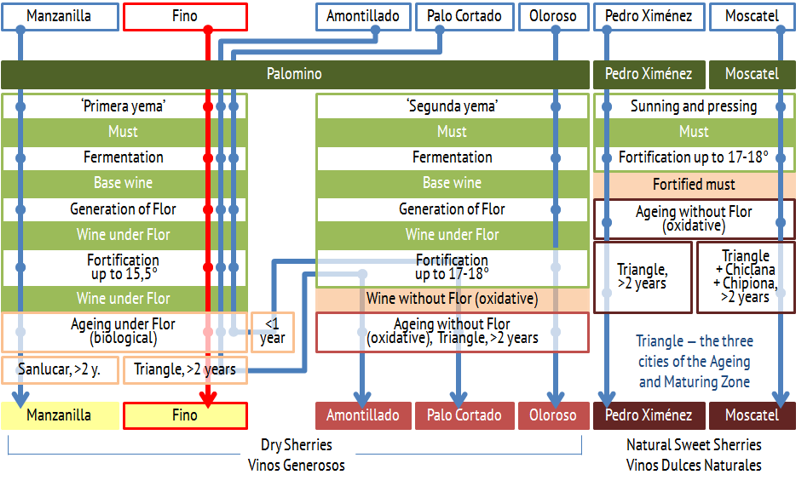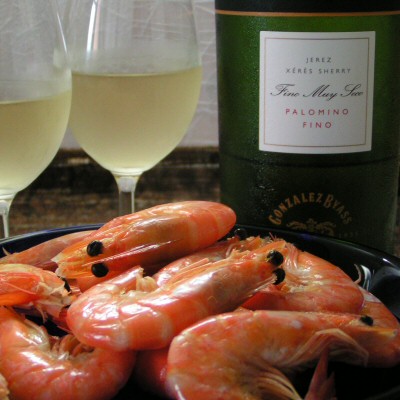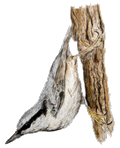
- Sherry Wine:
- Production
- Classification
- Cities & Bodegas
- Tastings
- Analogues
- Authors & Contacts
- Ðóññêèé ñàéò
Sherry wine types
Fino
Olga Nikandrova and Denis Shumakov.
Fino is a dry biologically-aged sherry.

The following technological aspects are important for the production of Fino.
First of all, for the base wine which is to become Fino after years of ageing first extraction must of Palomino grape is used. The first, more delicate, extraction (free-run juice in fact) is more suitable for the production of finer sherries.
Second, the Fino-to-be is fortified up to 15-15,5° — such fortification provides for the optimal conditions for biological ageing since it eliminates non-sherry yeasts and ‘feeds’ the sherry ones, which form a film on the wine surface called flor.
Third, the wine is aged under flor during two years minimum in the cities of the Ageing and Maturing Zone (indeed the term of ageing may be much longer, 8 years is quite a normal term). The ageing under flor has a great impact upon wine (flor reduces alcohol content, prevents darkening of the wine, and puts down the level of glycerol) and to a major degree determines its properties.
Forth, ageing under flor is done according to the dynamic scheme (in the Criaderas and Solera system), which means that the wine is constantly refreshed. If this is not done, flor dies or seizes its activity due to the lack of nutrients.
The result of all these operations made on the wine is sherry with alcohol strength of 15-17° and sugar content of less than 5 grams per liter, pale straw in color, with yellowish and greenish hues, light, bright and clear. Fino’s aroma is delicate almond, with tones of fresh yeast dough and meadow grass. The taste is dry and delicate, with a soft refreshing acidity. The aftertaste is lasting and pleasantly bitter.
Fino’s closest neighbor in the sherry line is Manzanilla. The main difference between Manzanilla and Fino is that the former may be aged only in Sanlúcar de Barrameda. Flor works more intensively there, so the wine differs in its properties.
The following sherry specialties may be produced on the basis of Fino.
1. Fino en Rama or Raw Fino. It is sherry which does not fully undergo the traditional filtering and clarification procedures done after the wine is taken from the solera and before bottling. It comes out racier, but it may “live” shorter time, depending on the filtering type (the finer — the longer). Nowadays “non-filtered” dry sherries become trendy, many bodegas start producing them and for experts and connoisseurs they are in the spotlight.
2. Fino Amontillado and Amontillado Fino sherries are very rare guests in the market. Rgeir names are not mentioned in the Regulatory Council’s official documents, they are used by manufacturer’s personal initiative. Fino Amontillado and Amontillado Fino are Finosherries where flor has almost died (Fino Amontillado) or completely died (Amontillado Fino) of natural causes due to the lack of nutrients so the sherry started a gradual transition from biological to oxidative ageing. We may say that in case of Amontillado Fino the “amontiladisation” process ran further than in Fino Amontillado, but since both these names are not formally regulated, only the producer of every particular drink can give an exhaustive explanation of the terms and differences between them.
3. Puerto Fino — Fino produced in El Puerto de Santa Maria. The difference in the climate between El Puerto de Santa Maria and Jeres de la Frontera has a small but notable effect on the character of drinks produced there and gives the producers the ground to separate Puerto Fino.
Fino in Spanish means “fine”, “elegant”, “delicate” and many other — mostly pleasant — words. This term is a perfect match to describe dry biologically-aged sherry.

Shrimps with sad eyes
and one of the most famous Fino
in the background
If you only begin to drink Fino (not a certain bottle of Fino, but this type of sherry in general) better use a special sherry glass (Catavino) or a glass for white wine. After you have learnt the main nuances of this drink, any glasses would go. A well-filtered Fino (which dominates the market) is better served chilled at 6-8°C — but it is absolutely fine if you let him warm up a bit while drinking. Depending on the serving temperature Fino’s organoleptic and gastronomic properties may change — and here is a very interesting field for experimentation. Lightly-filtered Fino is better served slightly cooled — too low temperatures will not reveal the “biological” tones which all this light filtering is about.
Fino may be matched with a lot of very different food. Perhaps, the only bad match would be frankly sweet deserts. Everything else may be a pair for Fino (especially when playing with its serving temperature). The Regulatory Council recommends to drink Fino with jamon, almonds, olives, salted and smoked tuna fish, anchovies in vinegar, cod and different other fish dishes, various salads, gazpacho, shrimps (and other seafood), sushi, bouillabaisse. We like drinking Fino with triple ruffe broth with perch, it is also wonderful with beef ragout, lamb or rabbit — and so on.
Cold Fino is a wonderful summer drink, it is good to cool one down when it is hot. Not so cold Fino goes fantastically well in our parts (Pskov and the vicinities) in the beginning of October, when, in the cool and still sometimes sunny air, a bright note of rotten leaves emerges, which rhymes perfectly with sherry’s aroma and taste.
One more remark. In the “northern” wine culture the sweet sherry stereotype is widespread. Buying a bottle labeled as Sherry (in any language) people very often expect to get a dessert wine. In such circumstances, Fino, being a purely dry wine, may be a deep disappointment. Thus, please, be careful and do not let unfortunate misunderstandings spoil the impression of a very tasty wine.
It is assumed that Fino is to be opened and consumed within a year and half after it was bottled. We consider this recommendation to be too general, it does not take into account the diversity and different quality of the wine, nevertheless it may be worthy to take note of. An uncorked and closed again bottle of Fino may be stored in the refregirator for a week without any notable loss of quality.
Fino sherries reviewed on the website (in Russian only):
— Lustau Fino Jarana
— Lustau Puerto Fino
— Fino La Ina
— González Byass Tio Pepe
— Osborne Fino Quinta
— Bodegas San Sebastián Fino La Barrosa
— Alvear Fino CB
— Colosia Fino
— Harveys Fino
— Equipo Navazos La Bota de Fino (nº 35)
— Don Pablo Fino Sherry
— Alvear's Fino
— Fino Romate
— Pedro’s Almacenista Selection Fino
— Fino Alexandro
— Lustau Fino del Puerto (Almacenista José Luis González Obregón)
— Osborne Fino
— Alexander Jules Fino 22/85
— Fino Tradición Mayo 2013
— Fino Cobos
— González Byass Una Palma 2014
— González Byass Dos Palmas 2014
— González Byass Tío Pepe Fino en Rama 2017
Read next — Manzanilla.
Warning!
This site can contain information about drinks excessive consumption of which may cause harm to health and is unadvisable for people who didn’t come of age.
Share Sherry
- Sherry.wine, FEDEJEREZ
- Copa Jerez, Sherry Week
- Sherry Notes, Jerez de Cine
- Los Generosos, Criadera
- Jerez-Xeres-Sherry
- Los Vinos de Jerez
Articles
- There are more articles in Russian than in English in this website. Sorry :(
Reviews
- To our great regret, we didn’t have time to translate tasting and traveling notes into English. But, if you want, you can see them in Russian.

